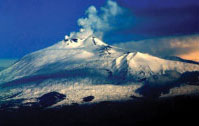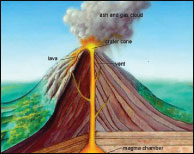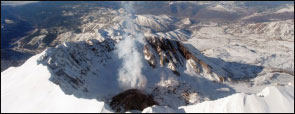|
Natural disasters:
Deadly volcanoes
Global warming and changing weather patterns have led to an increase
in natural disasters such as storms, hurricanes, tornados and floods
around the world.
|

Mauna Loa |
These natural disasters somehow seem to be 'mild' when compared to
some of the deadliest natural disasters such as earthquakes, tsunamis
and volcanic eruptions. During the last two weeks, we enlightened you
about earthquakes which occur rather frequently in some parts of the
globe.
Today we would like to educate you about volcanoes which can trigger
tsunamis, flashfloods, earthquakes, mudflows and rockfalls. They also
cause lateral blasts, mudslides, avalanches falling ash and floods.
Would you believe that more than 80 percent of the Earth's surface is
volcanic in origin? Some of the mountains we are so familiar with and
the sea floor or bed were formed as a result of continuous volcanic
activity while the gaseous emissions from volcanoes formed the
atmosphere.
So, let's check out what these 'monstrous' volcanoes that have the
power to cause so much of destruction really are.
Most of you must be aware of how the eruption of Italy's Mount
Vesuvious in AD 79 August 24 buried the entire Cities of Pompeii and
Herculaneum, killing thousands.
|

Mount Etna |
In recent history, we have been alerted to eruptions of Mount St.
Helens at various points of time because it is a very active volcano.
Scientists are closely monitoring this volcano. (see box story)There are
millions of volcanoes around the world, both on land and at sea.
In simple terms, a volcano is a landform (usually a mountain) that
opens downward to a pool of magma (molten rock) which is below the
surface of the Earth. You can call a volcano an opening in the Earth's
crust through which lava, ash and hot gases flow or are ejected during
an eruption.
What makes these holes in the Earth erupt you may wonder? Well, as
pressure builds up in the molten rock when the tectonic plates move
inside the Earth, it needs to escape. So, it forces its way up through
narrow cracks in the Earth crust known as fissures. However, the magma
that erupts to the Earth's surface, is no longer called magma when it
comes out. It is known as lava then.
The name volcano has its origin in the name Vulcun, a god of fire in
Roman mythology. Perhaps the spewing of molten lava would have been the
reason for it. There are many volcanoes around the world such as Mount
St. Helens in the US, Mount Vesuvious and Etna in Italy and Mount Fuji
in Japan. However, not all the volcanoes in the world are active - that
is, they do not erupt all the time or at all.
|

Mount St.Helens |
It is believed that there are about 600 active volcanoes and more
than half of them are found in the Ring of Fire, a region that encircles
the Pacific Ocean (see last week's map given with earthquake feature).
Scientists say there are at least 80 volcanoes under the ocean.
How many volcanoes are there in the world?
The exact number of volcanoes is unknown.
There are probably millions of volcanoes that have been active during
the whole lifespan of the Earth. During the past 10,000 years, there are
about 1500 volcanoes on land that areĀ known to have been active, while
the even larger number of submarine volcanoes is unknown.
At present, there are about 600 volcanoes that have had known
eruptions during recorded history, while about 50-70 volcanoes are
active (erupting) each year. At any given time, there is an average of
about 20 volcanoes that are erupting. Mauna Loa on Hawaii's Big Island
is considered to be the largest on Earth and is a shield volcano
constructed by countless lava flows.
It measures more than 17,000 m (56,000 ft) from the base to the top.
When measured from the sea floor it is more than 9,000 m, making it
the highest mountain on Earth, though Mt. Everest is officially the
highest as its only on land. Mauna Loa is also very heavy and has bent
even the mantle.
|

Mount Fuji |
The Fourpeaked Mountain located in Alaska was thought to be a dormant
volcano until it started showing signs of volcanic eruption in
September, 2007. Although there have been no major eruptions so far, a
mild steam emanating from the summit of the mountain has been noticed.
There are active volcanoes in the Southern area of Iceland too. The
Hekla volcano is reputed to be Iceland's most active and has recorded a
series of eruptions since the earliest recorded one in 1104. The last
eruption was recorded in 2000.
Many volcanoes have been in continuous eruptions for decades. Etna,
Stromboli, and Yasur have been erupting for hundreds or thousands of
years.
The following 4 volcanoes emit the most lava. Kilauea (Hawaii), Mt
Etna (Italy), Piton de la Fournaise (Reunion), Nyamuragira, (D.R.
Congo).
More on volcanoes next week.
Facts and pix: Internet
********
Quick facts
* There are three different types of volcanoes.

Active - eruptions can be anytime and often
Dormant - has not erupted in a while, but could at anytime.
Extinct - has not erupted in a very long time so, it probably wont,
ever again.
* The 1992 eruption of Mount Pinatubo in the Philippines Islands
caused 342 deaths and more than 250,000 people had to be evacuated.
* Ashfall is volcanic ash that has fallen through the air from an
eruption cloud. Fresh volcanic ash made of pulverised rock can be harsh,
acidic, gritty, glassy and smelly. The ash can cause damage to the lungs
of infants, the elderly and those with respiratory problems.
*A vent is an opening at the Earth's surface of a volcanic conduit.(a
passage or pipe followed by magma)
* Composite Volcano is a steep volcanic cone built by both lava flows
and pyroclastic eruptions.
Compound Volcano is a volcano that consists of a complex of two or
more vents, or a volcano that has an associated volcanic dome, either in
its crater or on its flanks. Examples are Vesuvius and Mount Etna.
* A crater is a steep-sided, usually circular depression formed by
either an explosion or collapse at a volcanic vent. Crater Lake in
Oregon was formed from a high volcano that lost its top after a series
of tremendous explosions about 6,600 years ago.
* The process by which solid, liquid, and gaseous materials are
ejected into the Earth's atmosphere and onto the Earth's surface by
volcanic activity is called eruption.
* A crack or fracture in the Earth's surface is known as a fault.
* Fissures are elongated fractures or cracks on the slopes of a
volcano.
* Geysers, springs that throw boiling water high in the air are
caused by volcanic heat warming trapped ground water.
*A hot spot is a volcanic centre, 60 to 120 miles across and
persistent for at least a few tens of million of years, that is thought
to be the surface expression of a persistent rising plume of hot mantle
material.
* Lava is magma which has reached the surface through a volcanic
eruption. Streams of liquid rock that flow from a crater or fissure. A
lava flow is an outpouring of lava onto the land surface from a vent or
fissure.
* Magma is molten rock beneath the surface of the Earth. While a
magma chamber (magna reservoir) is the subterranean cavity containing
the gas-rich liquid magma which feeds a volcano.
********
A peek inside Mount St. Helens
One of the most active volcanoes in the United States, Mount St.
Helens has been installed with a high-tech network of monitors.
 NASA
scientists now have the ability to get a peek into this volcanoe with
the placing of high-tech 'spider' pods inside and around the mouth of
St. Helens.It is believed that networks such as these could be used to
respond quickly in the event of an impending eruption. NASA
scientists now have the ability to get a peek into this volcanoe with
the placing of high-tech 'spider' pods inside and around the mouth of
St. Helens.It is believed that networks such as these could be used to
respond quickly in the event of an impending eruption.
These spider pods were lowered by cable from a helicopter hovering
about 100 feet up (30 meters) and gently put in hot spots inside and
around the volcano crater, on July 14 this year.
"This project demonstrates that low-cost sensor network system can
support real-time monitoring in extremely challenging environments,"
said WenZhan Song of Washington State University Vancouver. Song is the
principal investigator for this NASA-funded technology research project,
which also draws on participation from the U.S. Geological Survey and
from NASA's Jet Propulsion Laboratory, Pasadena, California.
These robotic emissaries were built to go where no human can and
operate in extreme temperatures and treacherous terrain. Fifteen pods
form a virtual wireless network, communicating with each other and the
Earth Observing-1 (EO-1) satellite, operated by NASA's Goddard Space
Flight Centre, in Greenbelt, Md.
|

Pods used are similar to this |
Each pod contains a seismometer to detect earthquakes; a GPS receiver
to pinpoint the exact location and measure subtle ground deformation; an
infrared sounder to sense volcanic explosions; and a lightning detector
to search for ash cloud formation. The main instrument box is the size
and shape of a microwave oven. It sits on top of a three-legged tripod,
which is why scientists call them spiders. The pods are powered by
batteries that can last for at least a year.
In 1980, a tremendous eruption at Mount St. Helens caused
considerable loss of life and damage. More recently, in 2004, the
volcano came back to life and erupted more than 100 million cubic meters
(26 billion gallons) of lava, accompanied by a series of explosions that
hurled rock and ash far from the vent. If eruptions like these ever
occur again, a sensor network could be quickly put in place to provide
valuable real-time information to scientists and emergency services.
The scientists hope this network will provide a blueprint for future
networks to be installed on many of the world's unmonitored active
volcanoes, so that educated and reliable estimates can be made when a
town or a village needs to be evacuated to reduce the risk to life and
property.
A team of engineers, students, volcanologists and geologists put the
system together. The team includes the U.S. Geological Survey's Cascades
Volcano Observatory staff, who designed and built the "spider" hardware;
Washington State University in Vancouver, where the sensor network
software was written; and NASA, which developed software to make the
spiders able to detect events to trigger space observations by the EO-1
satellite. |

